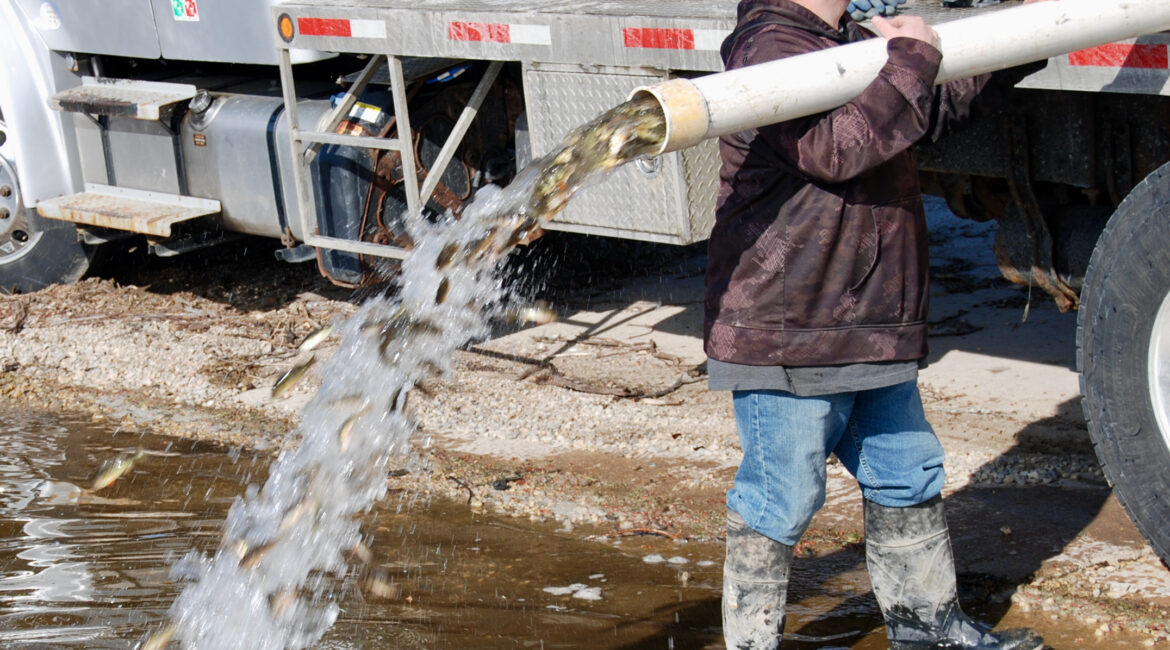By Kim McDarison
Anglers dotted the the Rock River early Friday morning as about 10 people, many of whom are involved with the Bark River Fish Hatchery and its associated fundraising group, awaited the arrival of a truck from Dodgeville carrying fingerling perch.
The group of volunteers and spectators was assembled at Island Bar and Grill, W7545 Blackhawk Island Road, where fundraising group, Friends of the Bark River Fish Hatchery, chairperson Adam Walton said the truck would find easy access to the shoreline near the confluence of the Rock River and Lake Koshkonong. This is the second year that perch were being introduced from the spot into the waterbody. The Friends of the Bark River Fish (sometimes called “Fry”) Hatchery is a fundraising arm that works to support the Bark River hatchery. The facility is located in the town of Koshkonong just outside of the Fort Atkinson city limits, near the confluence of the Rock and Bark rivers, Walton said. Fry is a term used to describe juvenile fish.
The Island Bar and Grill is owned by Jim and Christa Bowers. Jim Bowers is a Friends of the Bark River Fish Hatchery board member.
Stock market
This year, Walton said, some $11,000 in perch are being introduced into the lake. When the truck arrived, driver, Terry Lauffer said, he was carrying some 14,000 perch of varying lengths, ranging anywhere from 3-4 inches and up to 6-7 inches. The fish were between 1 and 3 years old, he said.
The fish were raised in Dodgeville at Gollon Bait and Fish Farm, Walton said.
“We used them last year, too. This is only our second year getting private-source stock,” he said, adding that the Wisconsin Department of Natural Resources (DNR), which owns the Bark River Fish Hatchery, is a partner in stocking the lake with fish. In past years, the DNR has stocked Lake Koshkonong with pike and walleye, he said.
Last year, the community fundraising group paid to stock Lake Koshkonong with some 20,000 perch, Walton said.
The DNR looks each year at waterbodies across the state and makes decisions about where fish will be stocked, he added.
“The DNR stocked fish in Koshkonong in 2019 and are planning to stock fish again this year,” Walton said, adding that the DNR plans to stock pike and walleye.
Last year, he said, plans to stock the lake with pike and walleye were hampered by DNR staffing issues caused by COVID-19.
Professionally, Walton offers an Edgerton-based guided fishing service. He is busy year-round, he said, and takes people on fishing trips throughout the state.
“We are busiest in the summertime, but in the winter, people go ice fishing,” he said.
At the hatchery in Dodgeville, eggs are collected from fish that are raised and grown on site. After the eggs hatch, the stock is raised in ponds on the facility’s property. After they reach a certain level of maturity, they are recaptured and brought to waterbodies within several states, including Wisconsin, Iowa, Illinois and Indiana, Lauffer said.
Lake Koshkonong and the recreational activities on the lake, including fishing, are important to the area, Walton said, adding: “Lake Koshkonong draws a lot of business to our restaurants and hotels, and bait stores, gas stations, so many businesses around the lake benefit. Lake Koshkonong is a magnet for that, so if the lake has great fishing, more people will come to the area.
“People don’t want to come and catch carp. Stocking these fish help create a healthy lake system and they will bring anglers from all over.”
Financing fish
Funds to buy fish that come through the club are collected through fundraising efforts, the biggest of which is the club’s annual March Banquet, Walton said.
This year, due to COVID-19 precautions, the banquet was not held, but the club had saved about $8,000 from earlier fundraising initiatives, and those funds, along with a donation of $3,000 from longtime Bark River Fish Hatchery affiliate Gary Peterson, were used to purchase the perch.
The club also provides funds for the DNR stocking of walleye and pike, and those fish are the bigger priority, Walton said. This year, they had enough money to include perch.
“We had extra money in the account which we put toward stocking, so perch were secondary to walleye and pike,” he said.
“Thanks to our gracious donors, we raised a lot of money last year,” he added.
“This year and last year, there was no banquet due to COVID, so we are using money that we had saved up,” he continued.
Looking ahead, Walton wrote in an update to club members, “Although banquet and group events still have restrictions, the DNR is back in operation and is planning to get stocking efforts back up and running this coming spring.
“Our board has been planning ahead financially for unforeseen events. Assuming nothing disastrous occurs, past money from fundraising events will cover this year’s walleye stocking despite not having a banquet.”
With a pause placed on banquet activities two years in a row, Walton said, the club’s resources are low. He anticipates replenishing the club’s coffers through fundraising and by resuming the banquet in 2022, he said.
New life in Lake Koshkonong
After making their journey by truck, the young fish were released from eight tanks into their new home.
In past years, Walton said, club members and volunteers would form a bucket brigade to transport fish from tanks into the lake.
This year, the process was done using a pipe that attached to the tanks and conveyed the animals into the water.
The process is quick, Lauffer said, taking only a few minutes to empty each tank.
As he moved the truck into position, several waterbirds began circling the area.
Some of the fingerlings will be lost to predators, he said, adding, with an eye toward the birds: “They seem to know I’m the lunch truck.”
Don Bush, a club board member with a long affiliation with the Bark River hatchery, was among those watching the release Friday morning.
Among fish that were being introduced into the lake were females that had not yet spawned, he said.
He hopes these fish will find adequate spawning habituate in Lake Koshkonong and bring to the lake a natural spawning cycle, he added.
Online information notes that perch can live to be 13 years old, and females mature when they are between the ages of 2 and 4 years old. The largest documented yellow perch every caught came from New Jersey. Caught in 1865, the fish weighed 4.3 pounds.
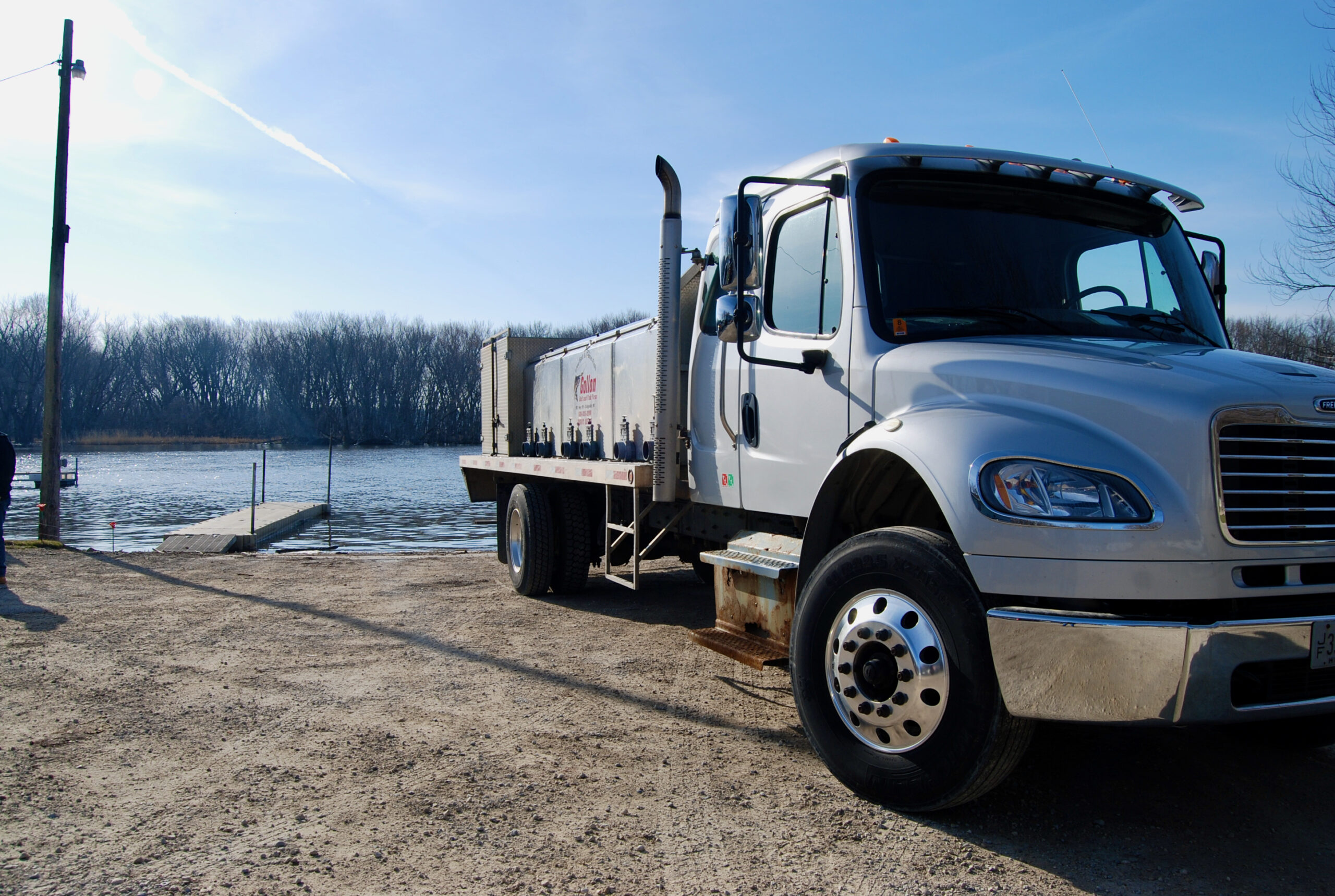
A Dodgeville-based Gollon Bait and Fish Farm truck carrying 14,000 juvenile perch arrives at the docks of the Island Bar and Grill, situated along the Rock River, early Friday morning.

After driver Terry Lauffer checks out the shoreline, the truck, with eight tanks full of perch, is maneuvered into position to release the fish into the waterbody.
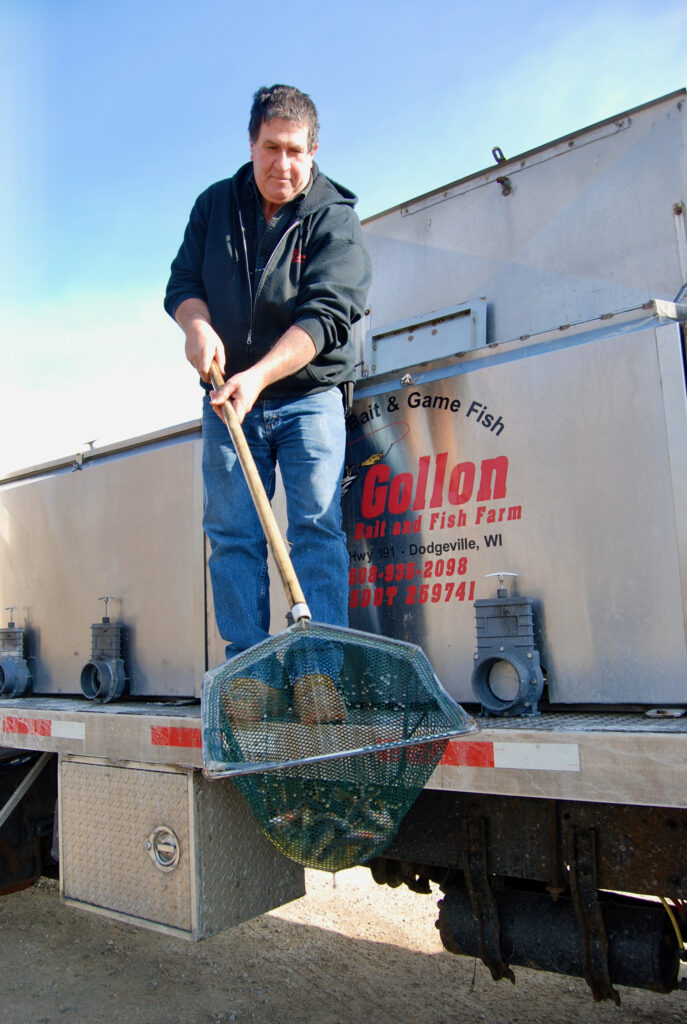
Gollon Bait and Fish Farm driver Terry Lauffer presents a sampling of the fish.

A closer look.
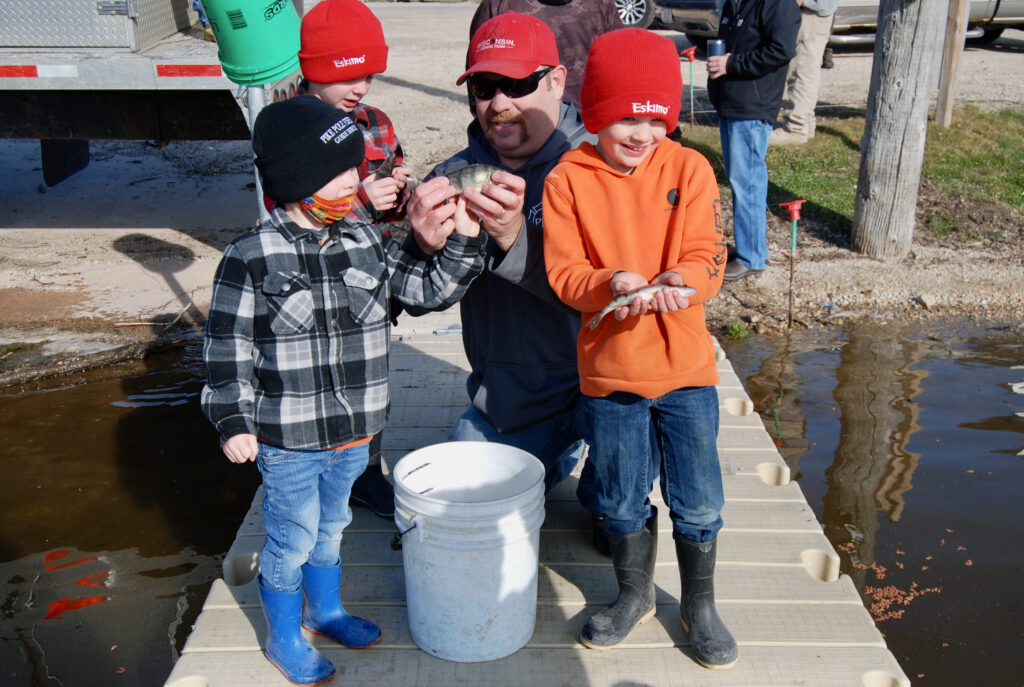
Friends of the Bark River Fish Hatchery Chairman Adam Walton and his sons, Clay, 4, from left, Jace, 6, and Reilly, 7, examine the fish.

A closer look.
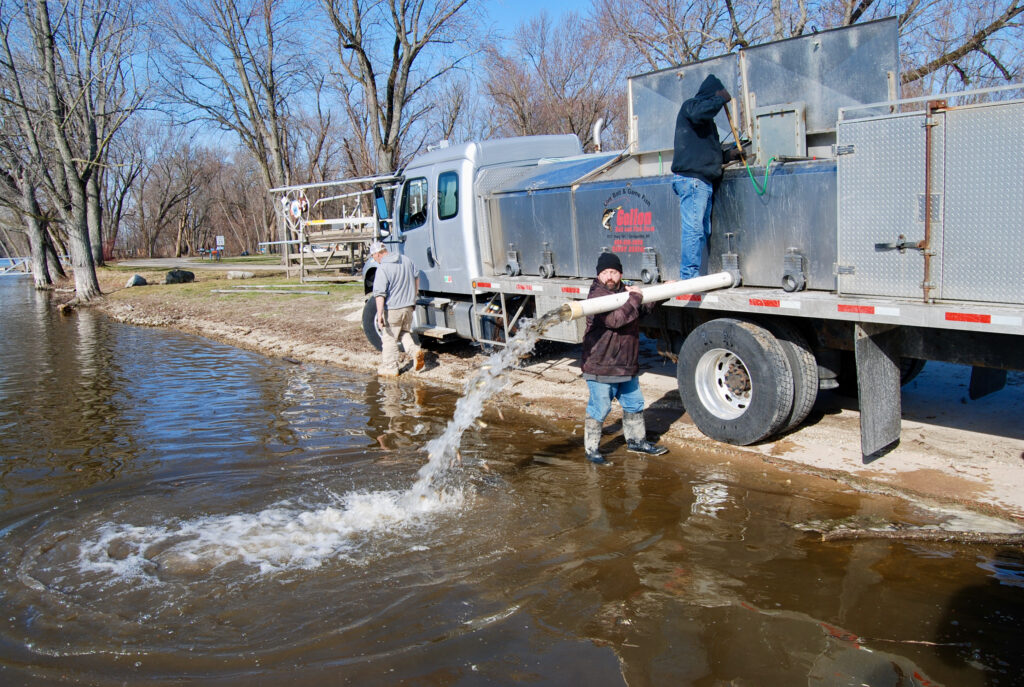
A piping system makes quick work of transporting the fish into their new home. Volunteer and longtime area resident Tony Prisk holds the pipe steady.
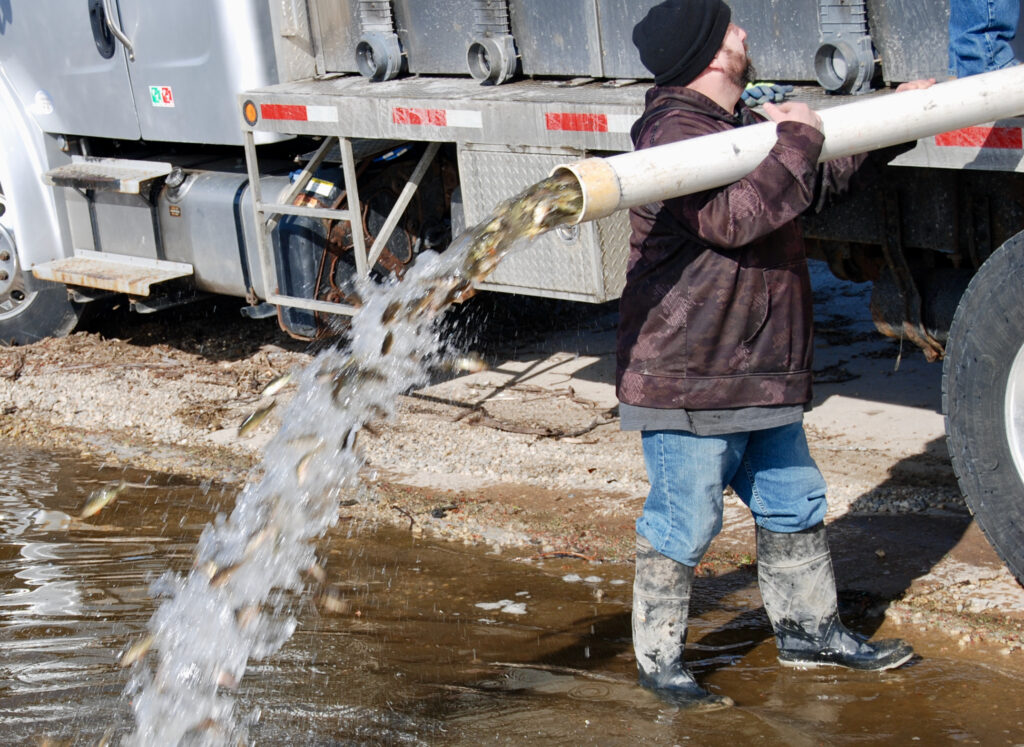
Fish cascade from the tank into the Rock River near where it joins with Lake Koshkonong.
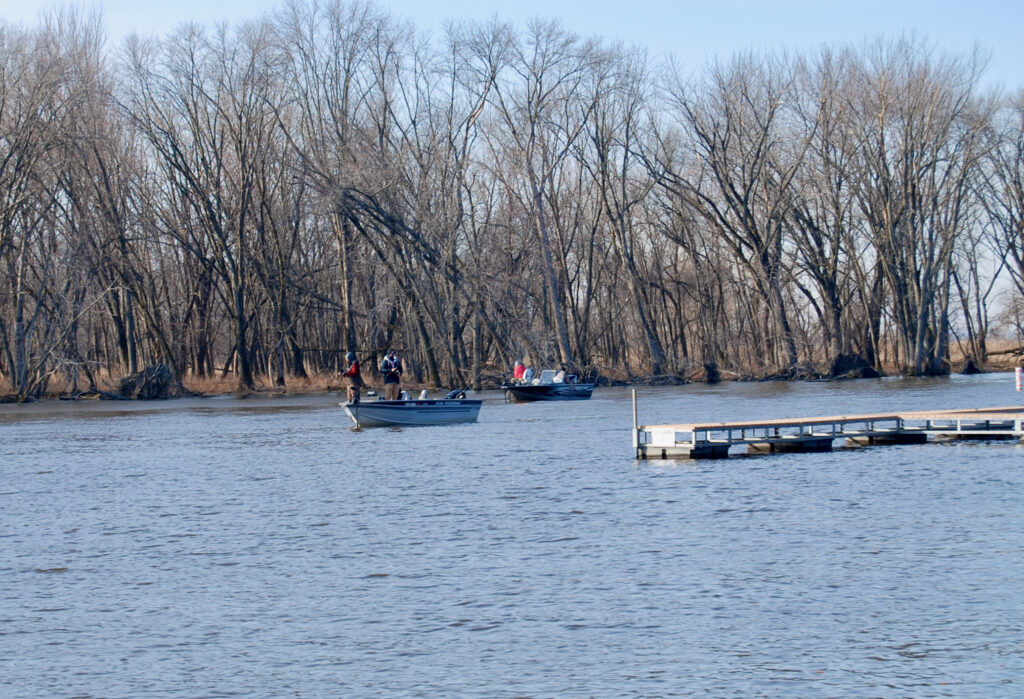
Fishermen enjoy a quiet morning near the release site along the Rock River.
Kim McDarison photos.
This post has already been read 2753 times!
